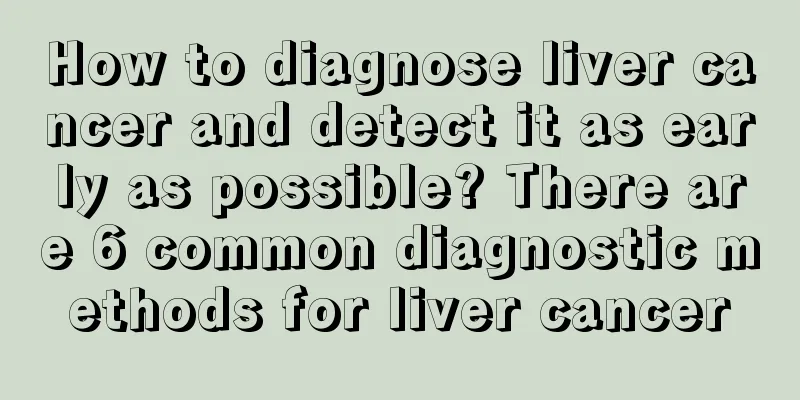How to diagnose liver cancer and detect it as early as possible? There are 6 common diagnostic methods for liver cancer

|
In recent years, the mortality rate of liver cancer has been extremely high, second only to lung cancer and stomach cancer. Most liver cancers are related to hepatitis B, hepatitis C and cirrhosis. There are no obvious symptoms in the early stage of liver cancer. Once symptoms appear, the cancer lesions are already very large, and often malignant tumors will appear within a few weeks. Therefore, hepatitis patients need to go to the hospital for regular check-ups and get diagnosed immediately if they have any adverse symptoms. What are the commonly used diagnostic methods for liver cancer? 1. Serum alpha-fetoprotein Serum alpha-fetoprotein is a tumor marker for diagnosing liver cancer. If the alpha-fetoprotein level in serum exceeds 400 micrograms per liter for one month, and exceeds 200 micrograms per liter for two months, liver cancer cannot be ignored, and further imaging examinations are required to confirm the diagnosis, provided that pregnancy and gonadotrophic embryonal carcinoma are excluded. 2. Blood biochemical examination Patients with primary liver cancer will have elevated aspartate aminotransferase, bilirubin or lactate dehydrogenase, decreased albumin, changes in liver function, and significant changes in immune indicators such as lymphocyte subpopulations. 3. Liver B-ultrasound Liver B-ultrasound is often used for liver cancer screening and is also used for follow-up after treatment. Ultrasound examination can detect small lesions in time and determine the relationship between cancer cells and blood vessels. Under ultrasound guidance, puncture biopsy can obtain histology to diagnose liver cancer. 4. CT or pET-CT examination CT is a commonly used imaging examination method, often used in routine diagnostic examinations, and also used for follow-up examinations after treatment. pET-CT examination can detect early lesions in a timely manner and understand whether the size and metabolism of cancer cells have changed after treatment. This examination method is safe and non-invasive. 5. Magnetic resonance imaging Magnetic resonance imaging is an imaging test used to further diagnose liver cancer and distinguish whether it is fatty liver, cirrhosis or liver cancer. After liver cancer patients receive interventional treatment, they can undergo magnetic resonance imaging to see if there are any residual cancer cells or recurrence. 6. Liver biopsy Liver biopsy is not recommended as a routine examination method because it will cause some trauma to the body, but it must be done when necessary. Liver biopsy is required when liver cancer cannot be diagnosed after alpha-fetoprotein, B-ultrasound and CT examinations. How to treat liver cancer? 1. Surgery Surgery is the first choice for treating liver cancer. Early detection and early resection can improve the quality of life and prognosis. Surgery includes liver resection and liver transplantation. Liver resection includes palliative and radical resection. The former refers to the removal of local or partial lesions, which can alleviate clinical symptoms and relieve pain. The latter refers to the complete removal of cancerous lesions. Liver resection can be performed in the early stage of liver cancer and with good liver function compensation, but residual cancer cells are likely to appear after surgery, so continuous treatment is required after surgery. If the patient cannot use radical surgical resection, palliative resection can be selected to relieve pain. Patients with small liver cancer or micro liver cancer with severe cirrhosis can undergo liver transplantation, which can reduce the recurrence rate. In addition, patients who cannot undergo surgical resection and radiofrequency microwave treatment and whose liver function cannot tolerate can also undergo liver transplantation. However, small lesions cannot be completely found during preoperative imaging examinations, so residual cancer cells may appear after surgery, leading to recurrence and metastasis of liver cancer. Therefore, for safety reasons, it is necessary to actively cooperate with doctors in antiviral treatment and radiotherapy and chemotherapy after surgery, which can reduce the recurrence rate. 2. Interventional treatment Patients with advanced primary liver cancer who cannot undergo surgery need interventional treatment. Patients with severe liver cirrhosis and the elderly can also use this treatment method. Injecting drugs into the hepatic artery can kill cancer cells without causing significant impact on other organs and with few side effects. Injecting embolic agents can block the blood supply to cancer cells, inhibiting their growth, while also slowly releasing anticancer drugs and prolonging their duration of action. Kind tips Liver cancer patients need to choose appropriate treatment methods according to their own conditions. At the same time, they need to face the disease correctly and not worry too much or become depressed. Even after receiving treatment, they should go to the hospital for regular checkups to understand their condition in a timely manner. |
Recommend
Attention! The three steps of gastric cancer
In recent years, gastric cancer has become one of...
Scientific diagnosis of osteosarcoma
For patients with osteosarcoma, scientific diagno...
What should I do if the heels of my leather shoes rub my feet?
The phenomenon of leather shoes rubbing the heels...
What is 300 degrees of myopia
Myopia has become an increasingly serious eye pro...
Is it good to have big ears?
The ear is an organ in our body that is used to h...
Where is the best place to get a massage for a cold
Colds are usually divided into wind-cold colds an...
What are the bad effects of smoking on our teeth
Smoking is a very relaxing thing for many people....
What to eat to gain weight?
Losing weight is a distressing thing, but gaining...
Can butter be eaten directly?
Butter is something that people use a lot in thei...
The dangers of congenital scoliosis, timely prevention to reduce complications
Congenital scoliosis is congenital so there is no...
Why does my right side of the stomach hurt when I walk?
Perhaps everyone has had this feeling: pain on th...
What are the treatments for lung cancer? 4 best treatments for lung cancer
Experts say that the current treatment for lung c...
Why does running give me stomachache
Many people often experience abdominal pain when ...
What causes tinnitus and dizziness
Health is something that deserves everyone's ...
What to do if you get inflamed under your nose
Getting angry is a word that we often hear. This ...









